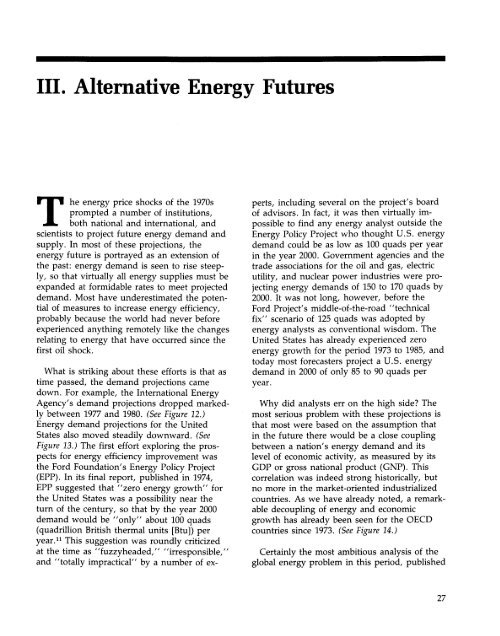ENERGY FOR A SUSTAINABLE WORLD - World Resources Institute
ENERGY FOR A SUSTAINABLE WORLD - World Resources Institute
ENERGY FOR A SUSTAINABLE WORLD - World Resources Institute
Create successful ePaper yourself
Turn your PDF publications into a flip-book with our unique Google optimized e-Paper software.
III. Alternative Energy Futures<br />
The energy price shocks of the 1970s<br />
prompted a number of institutions,<br />
both national and international, and<br />
scientists to project future energy demand and<br />
supply. In most of these projections, the<br />
energy future is portrayed as an extension of<br />
the past: energy demand is seen to rise steeply,<br />
so that virtually all energy supplies must be<br />
expanded at formidable rates to meet projected<br />
demand. Most have underestimated the potential<br />
of measures to increase energy efficiency,<br />
probably because the world had never before<br />
experienced anything remotely like the changes<br />
relating to energy that have occurred since the<br />
first oil shock.<br />
What is striking about these efforts is that as<br />
time passed, the demand projections came<br />
down. For example, the International Energy<br />
Agency's demand projections dropped markedly<br />
between 1977 and 1980. (See Figure 11.)<br />
Energy demand projections for the United<br />
States also moved steadily downward. (See<br />
Figure 13.) The first effort exploring the prospects<br />
for energy efficiency improvement was<br />
the Ford Foundation's Energy Policy Project<br />
(EPP). In its final report, published in 1974,<br />
EPP suggested that "zero energy growth" for<br />
the United States was a possibility near the<br />
turn of the century, so that by the year 2000<br />
demand would be "only" about 100 quads<br />
(quadrillion British thermal units [Btu]) per<br />
year. 11 This suggestion was roundly criticized<br />
at the time as "fuzzyheaded," "irresponsible,"<br />
and "totally impractical" by a number of experts,<br />
including several on the project's board<br />
of advisors. In fact, it was then virtually impossible<br />
to find any energy analyst outside the<br />
Energy Policy Project who thought U.S. energy<br />
demand could be as low as 100 quads per year<br />
in the year 2000. Government agencies and the<br />
trade associations for the oil and gas, electric<br />
utility, and nuclear power industries were projecting<br />
energy demands of 150 to 170 quads by<br />
2000. It was not long, however, before the<br />
Ford Project's middle-of-the-road "technical<br />
fix" scenario of 125 quads was adopted by<br />
energy analysts as conventional wisdom. The<br />
United States has already experienced zero<br />
energy growth for the period 1973 to 1985, and<br />
today most forecasters project a U.S. energy<br />
demand in 2000 of only 85 to 90 quads per<br />
year.<br />
Why did analysts err on the high side? The<br />
most serious problem with these projections is<br />
that most were based on the assumption that<br />
in the future there would be a close coupling<br />
between a nation's energy demand and its<br />
level of economic activity, as measured by its<br />
GDP or gross national product (GNP). This<br />
correlation was indeed strong historically, but<br />
no more in the market-oriented industrialized<br />
countries. As we have already noted, a remarkable<br />
decoupling of energy and economic<br />
growth has already been seen for the OECD<br />
countries since 1973. (See Figure 14.)<br />
Certainly the most ambitious analysis of the<br />
global energy problem in this period, published<br />
27

















